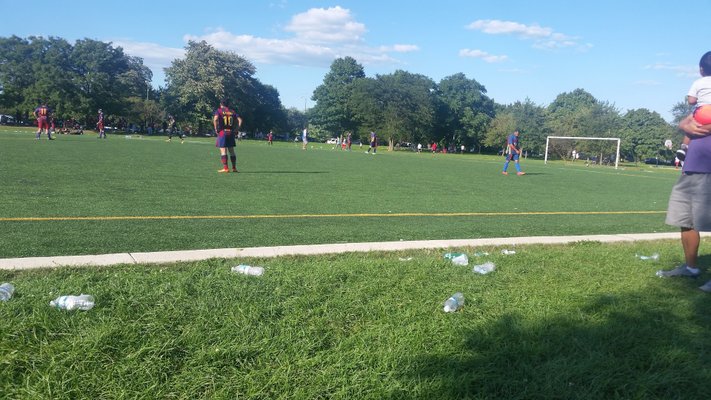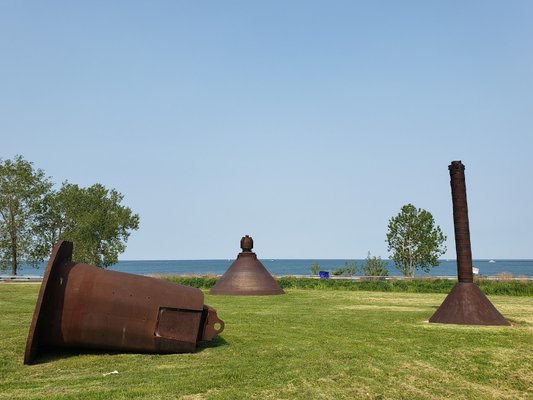Mentioned by CBS Chicago
10 Of Chicago’s Best Parks


"Boasting stunning views of distant skylines of Chicago, Rainbow Beach Park is situated on the southern side of Chicago. One of the best amenities the park offers is the complimentary Wi-Fi that visitors can use. The beach isn’t pet-friendly, but Rainbow Beach has abundant wildlife that both kids and adults can enjoy observing."
"It’s connected to a 60-acre park with a fitness center, community garden, basketball and tennis courts, a baseball diamond, and two playgrounds. Not every park and beach has programming, but here you can sign up for sports leagues or day camps. A post shared by Aaron M. Powell (@aaronisbla) on Oct 11, 2016 at 5:46pm PDT"
"Rainbow Beach Park boasts beautiful views of the Chicago skyline in the distance and is located in the southern part of Chicago. This park is one of the few that offers visitors free WiFi. Whether you want to work on the beach or simply relax, you’ll be connected."

"Burnham Park stretches six miles along the shores of Lake Michigan's Oakland Shoal from 14th Street to 56th Street, covering just shy of 600 acres of waterfront. The large Burnham Harbor takes up the shoreline from the park's northern end to 22nd Street, well-protected by Northerly Island. Burnham Park starts at the southern end of Grant Park, and is home to numerous attractions including Soldier Field, home of The Chicago Bears."
"Burnham Park runs for 6 miles (9.7 km) along Chicago's lakefront from Grant Park in the north to Jackson Park in the south, through the neighborhoods of Near South, Douglas, Oakland, Kenwood and Hyde Park."

"At 280 acres, Big Marsh certainly lives up to its name, but this far southeast side public park—opened in 2016 in the Calumet Area Reserve—is still a relative secret to most locals. The park includes 45 acres of recreation areas designed specifically for mountain and BMX biking and casual trail riding. The rest (234 acres) is a nature preserve great for hiking and bird-watching."
"Whether you want to relax with a nature walk or go on an adventurous hike, this park is a great place to check out. Forty-five acres of the park are dedicated to more intense endeavors, such as hiking, adventure courses and off-course biking. The other 235 acres is devoted to more passive activities like bird-watching and nature walking."

"Located in the Chicago Lawn neighborhood on the southwest side of Chicago, Marquette Park is the largest park on the southwest side totaling 323 acres. In addition to two gymnasiums, an auditorium, woodshop, Martin Luther King, Jr. kiosk and multi-purpose rooms, it's also home to one of the most affordable 9-hole golf courses in the city. Residents and visitors alike can enjoy a community garden, rose garden, prairie and 500 newly planted trees."
"Chicago Lawn is home to this huge 323-acre park, featuring two gymnasiums, an auditorium, four sports fields, a nine-hole golf course, fishing area, running paths, and a community garden. Don’t miss seeing the rose garden, prairie, and lagoon. A Dr. Martin Luther King, Jr. sculpture and an Art Deco Darius and Girenas Memorial are worth viewing as well."

"This slag-filled site at the confluence of Lake Michigan and the Calumet River was once home to the massive South Works U.S. Steel manufacturing plant that employed 20,000 workers at its peak. But the steel giant closed in the early ‘90s and the Chicago Park District acquired the vacant land. In 2014, it re-opened as Steelworkers Park—a 16.5-acre lakeside landscape dotted with pleasant walking paths, artifacts of the old U.S."

"Explore all 60 acres of Chicago’s historic Sherman Park on the city’s South Side. A big, circular ring-like pond encompasses the whole park, so you will never be far from views of the water. This historic park offers multiple baseball fields, a tennis court, and a basketball court."

"Known simply as the Midway, this mile-long natural stretch on the South Side connects the east end's Washington Park to Jackson Park on the west. Once the site of amusements during the 1893 Columbian World's Exposition (AKA World's Fair), the Midway is flanked by Hyde Park's noted gothic architecture, particularly the University of Chicago campus, and tree-lined boulevards, as well as outfitted with an ice skating rink and other facilities to keep folks visiting year-round."

"The Burnham Wildlife Corridor is a 100-acre area of urban wilderness running through Burnham Park. There is a bird sanctuary, a bioretention basin, nature paths, and a centennial prairie. Native prairie grasses, savanna, and woodland ecosystems create the largest natural area along the lakefront, according to the park district."


"The Burnham Wildlife Corridor is a 100-acre area of urban wilderness running through Burnham Park. There is a bird sanctuary, a bioretention basin, nature paths, and a centennial prairie. Native prairie grasses, savanna, and woodland ecosystems create the largest natural area along the lakefront, according to the park district."

"Of the numerous buildings that Frank Lloyd Wright designed around Chicago, none is more famous or influential than Robie House. Because its horizontal lines resembled the flat landscape of the Midwestern prairie, the style became known as the Prairie style. Inside are 174 stained-glass windows and doors, which you'll see on the hour-long tours (frequency varies by season, but there's usually at least one tour per hour). Advance tickets are highly recommended."
"Named one of the 10 most significant buildings of the 20th century by the American Institute of Architects, the 9,000-square-foot Robie…"

"Burnham Park stretches six miles along the shores of Lake Michigan's Oakland Shoal from 14th Street to 56th Street, covering just shy of 600 acres of waterfront. The large Burnham Harbor takes up the shoreline from the park's northern end to 22nd Street, well-protected by Northerly Island. Burnham Park starts at the southern end of Grant Park, and is home to numerous attractions including Soldier Field, home of The Chicago Bears."
"Burnham Park runs for 6 miles (9.7 km) along Chicago's lakefront from Grant Park in the north to Jackson Park in the south, through the neighborhoods of Near South, Douglas, Oakland, Kenwood and Hyde Park."


"The Parrot Cage, steps from the picturesque South Shore Beach, is run by one of the most highly acclaimed culinary schools in the country. Students from Chicago’s Washburne Culinary Institute use the restaurant to hone their skills in the kitchen, where they create highly rated modern American cuisine. The Parrot Cage is housed inside the landmark South Shore Cultural Center that provides a refined setting for your waterfront meal."

"Since the 1930s, this Bridgeport bar has been serving beer and shots to a customer base that fawns over this low-ceilinged space. Current ownership, the Badauskas family, took over the bar the 1950s. This charming corner bar even has an open mic for musicians."

"Hyde ParkTucked away behind the Museum of Science and Industry, 57th Street Beach was designed by renowned landscape architects Olmsted and Vaux as part of the 1893 World's Columbian Exposition. Parking is fairly easy west of Lake Shore Drive, and the beach is accessible via the pedestrian underpass. Once the sun goes down, head on over to nearby Promontory Point and gather around a bonfire pit (reservations needed).What to know: While the criminally underrated Promontory Point is worth a visit to this beach alone, nearby (and always bumping) neighborhood music venue The Promontory makes the trip even more appealing."
"57th Street Beach is one of Chicago's most popular swimming beaches, located within Jackson Park at 57th Street's terminus at the Lake Michigan shoreline. Though developed beachfront has existed at the site since the park's original landscaping by famed park designers Frederick Law Olmsted and Calvert Vaux in 1871, it was not renovated into a swimming beach until 1899, following the completion of Chicago's Drainage Canal. Today, it offers unprecedented views of the Chicago skyline for swimmers, along with a long-distance swimming area spanning between 55th Street and the beach's ADA-accessible pier."


"Calumet Beach is a lovely public beach within Chicago's Calumet Park, which was originally developed by the Olmsted Brothers in 1905 as an urban oasis for the city's crowded immigrant neighborhoods. The park, which was not completed until the 1930s, is named for the Norman-French term chamulet, or pipe, a reference to peace pipes traded between French traders and indigenous Great Lakes tribes. Today, its beach is open to the public daily between 6:00am and 11:00pm, with lifeguards staffed on duty during peak hours between Memorial Day and Labor Day."
"East SideLocated a stone’s throw away from the Indiana border, you'll find the delicious seafood spot Calumet Fisheries just a short 5-minute drive from here. Given that it’s not the most populated beach in Chicago, this stretch of shoreline is ideal for large gatherings. As part of the 200-acre Calumet Park, the area features a boat launch, softball and soccer fields, a playground, and several different concession stands."
"Nestled just steps away from the Indiana border, Calumet Beach is one beach in Chicago that’s least populated. The name of the beach is named as a way of tribute to the region of Calumet. This region is surrounded by several communities from the south side and the Calumet River."




































































































